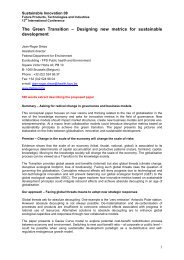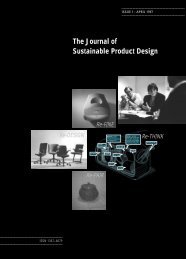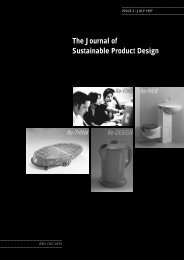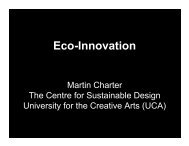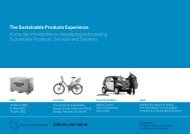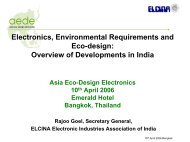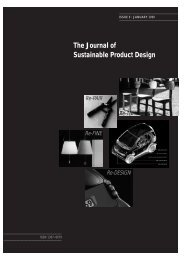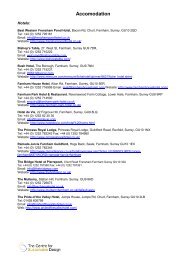Country report on the Indian electronics sector - The Centre for ...
Country report on the Indian electronics sector - The Centre for ...
Country report on the Indian electronics sector - The Centre for ...
You also want an ePaper? Increase the reach of your titles
YUMPU automatically turns print PDFs into web optimized ePapers that Google loves.
3.0 Implicati<strong>on</strong>s <strong>for</strong> suppliers<br />
3.1 Implicati<strong>on</strong>s of EU Directives and<br />
voluntary initiatives<br />
WEEE, RoHS and EuP as well as voluntary initiatives in <strong>the</strong> EU<br />
and elsewhere have an impact <strong>on</strong> <strong>the</strong> <strong>Indian</strong> electr<strong>on</strong>ics industry<br />
through <strong>the</strong> supply chain. <strong>The</strong> nature and extent of <strong>the</strong> impact<br />
varies depending <strong>on</strong> <strong>the</strong> type of product and <strong>the</strong> positi<strong>on</strong> of<br />
<strong>the</strong> manufacturer in <strong>the</strong> supply chain. <strong>The</strong> present secti<strong>on</strong><br />
summarises some of <strong>the</strong> most important implicati<strong>on</strong>s emerging<br />
from a survey of 16 <strong>Indian</strong> companies covering a range of<br />
products including cathode ray tubes, semic<strong>on</strong>ductors, printed<br />
circuit boards (PCBs), resistors, switches, relays, c<strong>on</strong>nectors,<br />
electr<strong>on</strong>ic parts, materials and envir<strong>on</strong>ment management<br />
services. Companies surveyed included multinati<strong>on</strong>al<br />
corporati<strong>on</strong>s (MNCs), large <strong>Indian</strong> companies and small<br />
and medium-sized enterprises (SMEs). For a more detailed<br />
descripti<strong>on</strong> of survey results see Annex 2.<br />
a: Awareness and preparedness<br />
<strong>The</strong> general awareness levels regarding <strong>the</strong> WEEE and RoHS<br />
Directives were found to be quite high. However <strong>the</strong> level<br />
of preparedness to implement <strong>the</strong> requirements remains a<br />
matter of c<strong>on</strong>cern, especially am<strong>on</strong>gst SMEs manufacturing<br />
capacitors, resistors and o<strong>the</strong>r passives. Larger companies<br />
producing PCBs and c<strong>on</strong>nectors were <strong>the</strong> most advanced in<br />
terms of readiness to meet internati<strong>on</strong>al norms.<br />
b: Technology and process changes<br />
<strong>The</strong> lead imbroglio<br />
Replicati<strong>on</strong> of <strong>the</strong> successful transiti<strong>on</strong> to lead free processes in<br />
Japanese companies may prove difficult <strong>for</strong> <strong>Indian</strong> companies<br />
without active collaborati<strong>on</strong> with o<strong>the</strong>r players in <strong>the</strong> supply<br />
chain. Perfecting technology trans<strong>for</strong>mati<strong>on</strong> and reaching<br />
satisfactory volumes of producti<strong>on</strong> with lead free processes<br />
to achieve ec<strong>on</strong>omies of scale can take a lot of time with <strong>the</strong><br />
possibility of several cases of per<strong>for</strong>mance failure.<br />
<strong>Indian</strong> industry will have to learn from <strong>the</strong> successes and failures<br />
of switching to lead-free processes. For over 50 years, soldering<br />
processes throughout <strong>the</strong> world used lead in <strong>the</strong> electr<strong>on</strong>ics<br />
industry to fix comp<strong>on</strong>ents to printed circuit boards (PCBs).<br />
<strong>The</strong> most preferred alternate choice now is <strong>the</strong> tin-silver-copper<br />
mixture. But it is argued that <strong>the</strong>re is still no superior alternative<br />
to <strong>the</strong> traditi<strong>on</strong>al tin-lead solder in terms of reliability and cost.<br />
<strong>The</strong>se substitutes to lead are found to have varying melting<br />
temperatures and many producers are still exploring alternative<br />
assembly processes. Credible <str<strong>on</strong>g>report</str<strong>on</strong>g>s based <strong>on</strong> actual<br />
experience of manufacturers raise doubts about <strong>the</strong> robustness<br />
and efficacy of lead-free alternatives. Apart from higher cost,<br />
lead free processes can harm comp<strong>on</strong>ents. Not <strong>on</strong>ly can<br />
passives and PCBs be damaged by lead free processes that<br />
require 30–40 degrees higher temperature and l<strong>on</strong>ger heating<br />
time, <strong>the</strong>ir reliability is also in questi<strong>on</strong>. Manufacturers will have<br />
to be far more cautious about quality aspects. It is expected<br />
that <strong>the</strong> initial transiti<strong>on</strong>ary phase <strong>for</strong> India to lead free processes<br />
will be potentially quite difficult, with improvements taking place<br />
as volumes pick up and processes stabilise.<br />
Restricti<strong>on</strong>s <strong>on</strong> copper<br />
Large quantities of copper are used in manufacturing laminates<br />
and PCBs. Aluminium could be a viable alternative when<br />
produced in foil <strong>for</strong>m and laminated to all comm<strong>on</strong> materials,<br />
such as epoxy glass, with acceptable peel strengths. It is felt<br />
that aluminium PCBs will be easier to recycle than copper<br />
<strong>on</strong>es. <strong>The</strong> process of plating through holes using copper is<br />
polluting. Ef<strong>for</strong>ts are underway to replace this <strong>for</strong>ty year process<br />
technology by o<strong>the</strong>r cleaner alternatives such as gold plating.<br />
An <strong>Indian</strong> PCB company has successfully refined this process<br />
of gold plating to bring down costs. Gold (as well as Nickel) is<br />
regularly recovered from spent soluti<strong>on</strong>s and is also recovered<br />
from rejected boards.<br />
c: Costs of compliance<br />
Asia Eco-Design Electr<strong>on</strong>ics (AEDE) · 13<br />
<strong>The</strong> WEEE Directive places <strong>the</strong> <strong>on</strong>us of covering recycling costs<br />
<strong>on</strong> <strong>the</strong> equipment ‘producers’ based in Europe, typically brand<br />
vendors, distributors or importers. <strong>The</strong> producer is defined as<br />
<strong>on</strong>e who manufactures and sells electr<strong>on</strong>ic equipment under<br />
his own name, or resells under own brand equipment produced<br />
elsewhere, or imports/exports electr<strong>on</strong>ic equipment into <strong>the</strong><br />
EU. Although <strong>the</strong> WEEE Directive does not cover comp<strong>on</strong>ents<br />
or sub-assemblies and <strong>the</strong> accountability rests with <strong>the</strong> final<br />
producer, comp<strong>on</strong>ent and sub-assembly makers will be<br />
affected through <strong>the</strong> supply chain. Much would depend <strong>on</strong> <strong>the</strong>ir<br />
ability to secure a firm place in <strong>the</strong> supply chain by producing<br />
goods that meet <strong>the</strong> specificati<strong>on</strong>s of <strong>the</strong> final equipment<br />
producer. <strong>The</strong> direct impact of <strong>the</strong> WEEE Directive <strong>on</strong> <strong>Indian</strong><br />
companies is negligible as very few export finished equipment<br />
to Europe. <strong>The</strong> excepti<strong>on</strong>s may be very large <strong>Indian</strong> companies<br />
such as Videoc<strong>on</strong> and Onida who have capability to deal<br />
with European WEEE. RoHS has a much greater impact <strong>on</strong><br />
<strong>Indian</strong> companies as a large number export comp<strong>on</strong>ents and<br />
electr<strong>on</strong>ic sub-assemblies to Europe.<br />
<strong>The</strong> precise recycling cost to producers varies significantly<br />
across countries. Greenpeace estimates that <strong>the</strong> recycling<br />
costs of a PC will be $20 in <strong>the</strong> US and $2 in India. <strong>The</strong> lowest<br />
compliance cost is that of cell ph<strong>on</strong>es, estimated at little over<br />
$1. Costs will decline as competiti<strong>on</strong> picks up and ec<strong>on</strong>omies<br />
of scale come into full swing in <strong>the</strong> recycling processes. It is<br />
expected that all players in <strong>the</strong> supply chain will end up paying<br />
some share of <strong>the</strong> final recycling cost, and that a porti<strong>on</strong> of this<br />
cost will be passed <strong>on</strong> to c<strong>on</strong>sumers.<br />
Given practical difficulties and cost implicati<strong>on</strong>s, recycling<br />
programmes deserve more attenti<strong>on</strong>. <strong>The</strong> <strong>Indian</strong> industry and<br />
government should, <strong>the</strong>re<strong>for</strong>e, closely track <strong>the</strong>se global trends<br />
to evolve <strong>the</strong>ir strategies and acti<strong>on</strong> plans. It is desirable <strong>for</strong>



